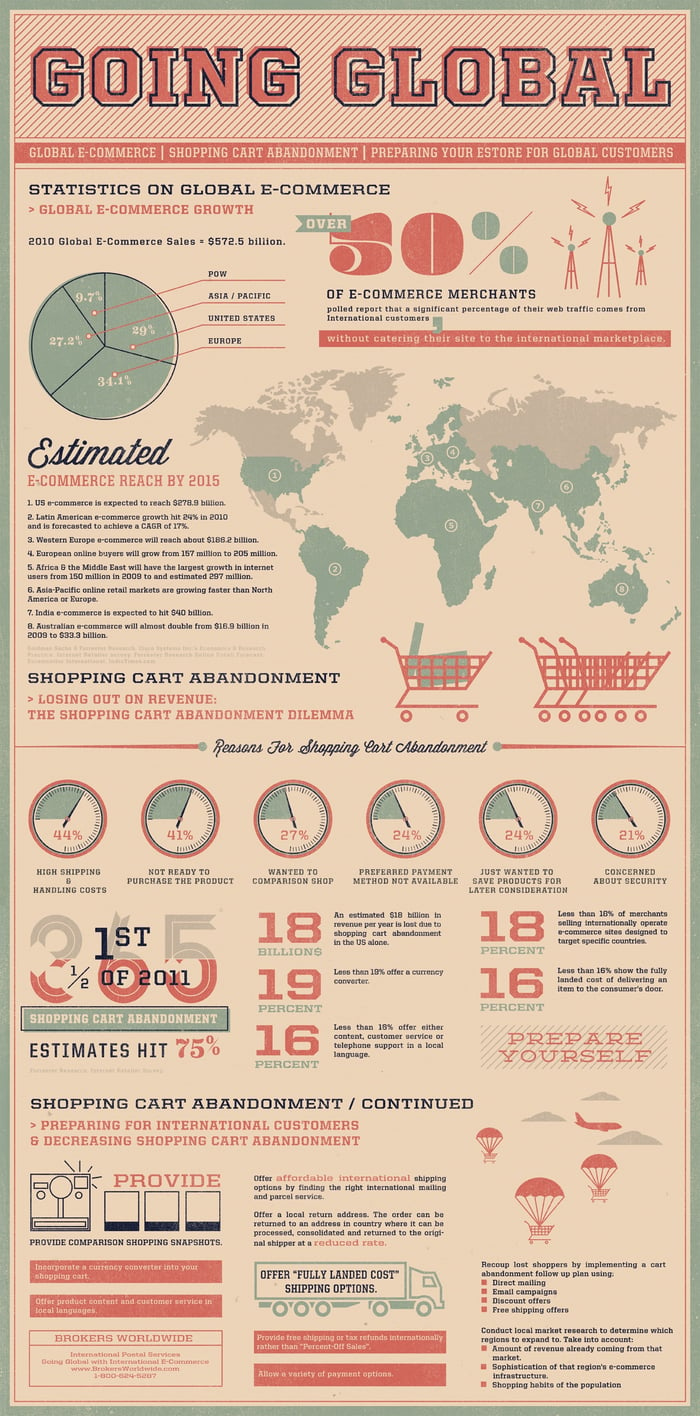
Many eCommerce businesses set the goal of going global. Even the smallest business can grow enough that they set their sights on the worldwide market. After all, eCommerce is already about reaching an audience beyond the "local." So, going global can feel like the natural next step for a business that's already serving an entire country.
However, you shouldn't rush into going global. It might seem simple to start marketing your online store internationally, but it's not as easy as that. If you're not careful, you could make a costly mistake that could harm your efforts to expand to a region. If an area's culture is vastly different from your own, there's an even bigger risk.
Here are some crucial tips for expanding your online business globally.
1. Study the International Market

Market research is an important step to take before you start selling a product at all. It's how you determine what your prices should be, who your target audience is, and more. So, it's even more vital when you plan to go global — even if your products already sell well in your own country.
Be sure to find out as early as possible if you'll be competing with a local brand. Depending on the market, it may be extremely difficult to gain a foothold, if you can even do so. Customers always prefer to shop from familiar brands. So, they'll be even more hesitant to buy from a foreign company over a local one, unless you're bringing a unique value proposition compared to the established businesses.
Consider whether demand for your product (or products) even exists in certain regions. Differences in culture, climate, and many other factors can all affect this. In some cases, you may discover a demand, but your target audience may be totally different than in your home country. For example, a type of product that's relatively common in your country could be considered a luxury item in others. A more extreme example would be a product that's common and legal in your country, but outright illegal in other areas.
Finally, you may already be getting hints about markets you haven't yet tapped into. For example, if you're getting a lot of web traffic from a certain region, people located there might already be interested in your products (unless they've arrived at your site completely by accident, which would be something else you'd need to investigate. Check out your referring links to see how they're finding you before you commit to pursuing expansion there).
An even clearer signal that you should expand to a certain market is receiving inquiries from interested shoppers. If you frequently get asked "Do you ship to the UK?" that could be your first target for expansion. Clearly, people already want to buy from you!
2. Learn to Look "Local"

Above all, customers need to feel comfortable buying from you. This can be one of the biggest hurdles to overcome when going global. Depending on how different your own country and culture are from the ones you're expanding into, you could find it extremely difficult to give those customers the experience they're looking for.
First off, put effort into understanding the cultural differences between your home country and anywhere you're interested in expanding to. If you make a mistake, your brand could look silly, or even get a bad reputation right out of the gate. A common cause of this is the failure to understand the local language — and it's not just about a potentially bad translation, but also the tone you take. You could produce a perfectly accurate translation of your website and still miss the mark.
Why? Because a perfect translation doesn't necessarily capture the tone your brand might need to take with its target audience. For example, rigid, formal language may be completely accurate, but it won't work when you're aiming to draw a younger crowd that uses their own colloquial language, slang, or simply a more casual mood.
This is why having a diverse marketing team is crucial. If you can hire locals in your new target country or region (whether as salespeople, language consultants, or other kinds of branding or marketing agents), you're at a huge advantage. Even though new customers might realize you're a foreign company, they'll notice you put actual care into reaching them.
Also keep in mind that you'll need to be prepared for different atmospheres in different countries. What works among one culture might be an embarrassment in another. You never want to be perceived as out of touch or insensitive.
3. Focus on Quality and Satisfaction

You want your customers to feel like they're buying from a local business, even if your home office is on the other side of the world. Being approachable and communicating well are just part of making customers comfortable buying from you. Quality assurance and customer satisfaction are also huge factors. In short, you need to give your global customers the same type of experience (or better) than they can get when they buy from a local business.
Any products you sell need to be at least on par with the quality of any competitors' products coming from your target country. The rest of the customer experience needs to equal or exceed that as well, including shipping times, customer service and support, and everything else.
Unless your product is exceptional, customers won't be willing to wait too long to receive their order, especially if they could get a local substitute more quickly. If shipping takes too long from your current warehouse locations, you should look into opening a distribution center for the new region.
Likewise, your customer service should also be "localized." It's not enough to have representatives who can speak the local language if they're working under office hours incompatible with your target region. This can be an especially big problem if you're in a vastly different time zone. No customer wants to be awake at 4 in the morning because that's the only time they can speak to your customer service! At least your regional customer service representatives don't actually need to be in the same country (unlike your new distribution center might need to be), but they do need to be available during compatible hours.
Remember that your ultimate goal for this part of the process is to provide a local feel for your customers no matter where they are. This means quick response times that fit into their schedules, including both shipping and service.
If you have a distribution center in another country, you may also consider manufacturing there as well, but be sure your products reach the same high standards no matter where they come from. The point is to offer the same high level of service to all customers, globally.
4. Watch Out for Roadblocks

Another reason to open multiple distribution centers is to avoid certain issues like extra costs for your customers. Taxes, fees at customs, and other extra expenses like high shipping costs can simply make your products too expensive for global customers, even if your products are reasonably priced.
So, the advantage of distributing or even manufacturing in other regions, to serve surrounding countries, is more than just shorter shipping times. It can also save your customers a lot of money.
If you enter a foreign market without these preparations, you can be surprised by just how much extra your new customers need to pay to buy your products. This will lead to dissatisfaction, and can even cause you to fail at your attempt to expand into new global markets.
Being prepared for these costs ahead of time will help you understand how to expand in a way that both you and your customers can afford.
5. Use Tools Local to Your New Customers

Social media is enormously popular all over the world, and it only continues to grow every year. But customers around the world prefer different platforms, and may not even be able to access the ones you're familiar with.
For example, since so many social media platforms (like Facebook and YouTube) started out in the United States, it's easy to assume that they're the most popular platforms worldwide. But this is a mistake. Some countries can't access the same platforms as others — famously, Facebook is banned in China, and other countries occasionally impose similar censorship.
However, even if your most familiar social media platforms aren't banned, they simply might not be as popular in countries you're most interested in targeting. New platforms are making a larger footprint in the industry around the world. Digital Marketing Institute has a good breakdown of worldwide social media usage, as well as which platforms are most popular in which countries.
To really connect with a global audience, you'll have to speak to people all over the world on their own terms, and that means using the same platforms they do.
Large global marketplaces also already exist and can help you reach across international boundaries, doing most of the work for you. While not guaranteed to be available in every country, marketplaces like Amazon, Rakuten, eBay, and others are popular around the world. It can be a safe bet to start expanding globally by selling on these marketplaces before you invest in local distribution centers.
You can even push your products quickly and easily to worldwide marketplaces from your own eCommerce website, provided you use the right eCommerce software. For example, Shift4Shop is integrated with Amazon and eBay as well as other marketplaces, and you can further expand this feature with an app such as ChannelUnity. ChannelUnity allows you to push your products to multiple worldwide marketplaces using the same information you've already provided in your Shift4Shop store, and synchronizes your inventory levels, prices, images, and much more. Orders are imported into your Shift4Shop dashboard and automatically updated when you fulfill them. With this set of tools, you can sell on multiple marketplaces worldwide and manage it all in a single dashboard.
6. Don't Try to Grow Faster Than You Can Handle

We've referred to "your target country or region" several times in this article. Of course, your goal is to expand globally. But this is a massive undertaking, and like most other large jobs, it's easier when broken into steps.
Always consider the resources your business has at its disposal. It might be impossible to effectively (and successfully) expand into multiple countries or regions at once, especially if they're very different, and even more so if you have limited staff or capital.
A methodical approach might be best to ensure you avoid spreading yourself too thin. Trying to rush an expansion into multiple countries at once can harm your overall efforts. Remember that your business is in a vulnerable stage when it enters a new country, so you need to ensure you can devote the proper time, attention, and resources to establishing yourself. Trying to push too aggressively into a new market can mean you overlook important steps for building yourself up in another new market you just entered.
The pace at which you grow should always be comfortable for your budget and staff. But being careful doesn't mean sacrificing your growth and profits. You can still jump into the international market through large marketplaces like we mentioned in the previous tip, while working on your own independent presence around the globe. Eventually, your business may be able to stand on its own without the marketplaces.
7. Create a Thorough (and Repeatable) International Business Plan

Planning is the key to everything. You never want to feel unsure about what you should do next. Nobody should try to start a business without a detailed business plan, and the same goes for expanding globally.
The best international business plan takes variables into account so it can be flexible enough to be used in different countries or regions. You shouldn't need to start from scratch for every new target area. But you should ensure the essentials are always covered, including market research, cultural education, expense analyses, and more. You can start with your original business plan and use the information in this article to expand it onto an international scale.
Regularly audit your results, not just to track your progress, but also to see how well your plan is working. If you do need to make any adjustments, don't feel obligated to stick to the original plan if something isn't working. However, don't make big changes without the data to back it up.
8. Always Be Scalable

Why do businesses go global? To grow their audience. What does growing an audience mean? Hopefully, more customers.
But having more customers also means your infrastructure, including your eCommerce website, is going to be under a much bigger strain.
It's better to build a solid foundation at the beginning than to need to struggle to fix things when you suddenly realize your infrastructure isn't up to the task. That's why you should focus on eCommerce scalability, meaning, the ability to grow to any size and support any amount of web traffic and sales.
Some businesses make the mistake of starting out with software that only supports businesses up to a certain size, and then needing to replatform once they outgrow it. This is a mistake because it can waste time and resources and cause periods where your site slows down, or even collapses under the weight of a growing audience. It's not world-ending, as many businesses replatform successfully. But if you haven't started out on a fully scalable eCommerce platform, it's always better to do so before you try to expand any further, rather than once you start having issues.
Shift4Shop is a fully scalable eCommerce platform that can handle any size business, from a one-person startup to a huge international enterprise, so it's an example of a great choice for going global.
Conclusion
Running a business is always a challenge, and global expansion brings a whole new set of challenges to the table. But if you understand what you're doing, and make a plan ahead of time, you can avoid the pitfalls that could cause you to fail. Remember:
- Study the international market
- Learn to look "local"
- Focus on quality and satisfaction
- Watch out for roadblocks
- Use tools local to your new customers
- Don't try to grow faster than you can handle
- Create a thorough (and repeatable) international business plan
- Always be scalable
If you take the right approach and arm yourself with knowledge, you'll create a win-win situation for both you and the customers you serve. Your business can achieve the success you dream of, as a global business that feels local to your customer base.






Leave a reply or comment below